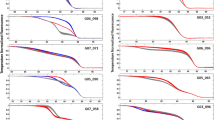Summary
The maximum temperature (34°C) at which perennial ryegrass plants from one breeding population successfully shed pollen was determined and the seed set of ten clones taken from the same population and self-pollinated both in an unheated glasshouse and at a constant 34°C during anthesis was compared. Seed set by selfing of all ten clones was markedly increased by heat treatment, from a mean of 2.3% to 30.7%. Heat treatment of anthers, but not stigmas, greatly enhanced pollen tube growth on stigmas from the same genotype. Germination of progeny was not affected by the heat treatment. Heat treatment of ten clones from a breeding population with contrasting morphology and growth rate was not so successful. Only one clone shed pollen freely at 34°C and showed a marked improvement in subsequent seed set. The advantages to the breeder of routinely producing full-sib families of elite perennial ryegrass parents by selfing are outlined.
Similar content being viewed by others
References
Cornish M.A., M.D. Hayward & M.J. Lawrence, 1979. Self-incompatibility in ryegrass. I. Genetic control in diploid Lolium perenne L. Heredity 43: 95–106.
Elgersma A., 1990. Seed yield related to crop development and to yield components in nine cultivars of perennial ryegrass (Lolium perenne L.). Euphytica 49: 141–154.
England F.J.W., 1974. The use of incompatibility for the production of F1 hybrids in forage grasses. Heredity 32: 183–188.
Gertz A., Wricke, 1991. Inheritance of temperature-induced pseudocompatibility in rye. Plant Breeding 107: 89–96.
Heslop-Harrison J., Y. Heslop-Harrison & K.R. Shivanna, 1984. The evaluation of pollen viability and a further appraisal of the fluorochromatic (FCR) test procedure. Theor. Appl. Genet. 67: 367–375.
Jones R.N. & P. Jenabzadeh, 1981. Variation in self-fertility, flowering time and inflorescence production in inbred Lolium perenne L. J. Agric. Sci. 96: 521–537.
Lalouette J.A., 1967. Growth of grass pollen when exhibited by the callose fluorochrome reaction. Grana Polynologica 7: 601–603.
Lundqvist A., 1961. A rapid method for the analysis of incompatibility in grasses. Hereditas 47: 705–707.
Marshall C. & D. Ludlam, 1989. The pattern of abortion of developing seeds in Lolium perenne. Ann. Bot. 63: 19–27.
Mascarenhas J.P., 1990. Gene activity during pollen development. Ann. Rev. Pl. Physiol. Mol. Biol. 41: 317–338.
Thorogood D. & M.D. Hayward, 1991. The genetic control of self-compatibility in an inbred line of Lolium perenne L. Heredity 67: 175–181.
Utz H.F. & G. Oettler, 1978. Performance of inbred lines and their top crosses in perennial ryegrass (Lolium perenne L.). Z. Pflanzenzücht. 80: 223–229.
McVetty P.B.E., S.A. Edie & R. Scarth 1990. Comparison of the effect of nap and pol cytoplasms on the performance of intercultivar summer oilseed rape hybrids. Can. J. Pl. Sci. 70: 117–126.
Wilkins, P.W., 1991. Recent yield improvements through recurrent half-sib family selection in perennial ryegrass. Proc. Eucarpia Fodder Crops Sect. for 1990, Wageningen: 71–72.
Author information
Authors and Affiliations
Rights and permissions
About this article
Cite this article
Wilkins, P.W., Thorogood, D. Breakdown of self-incompatibility in perennial ryegrass at high temperature and its uses in breeding. Euphytica 64, 65–69 (1992). https://doi.org/10.1007/BF00023539
Received:
Accepted:
Issue Date:
DOI: https://doi.org/10.1007/BF00023539




